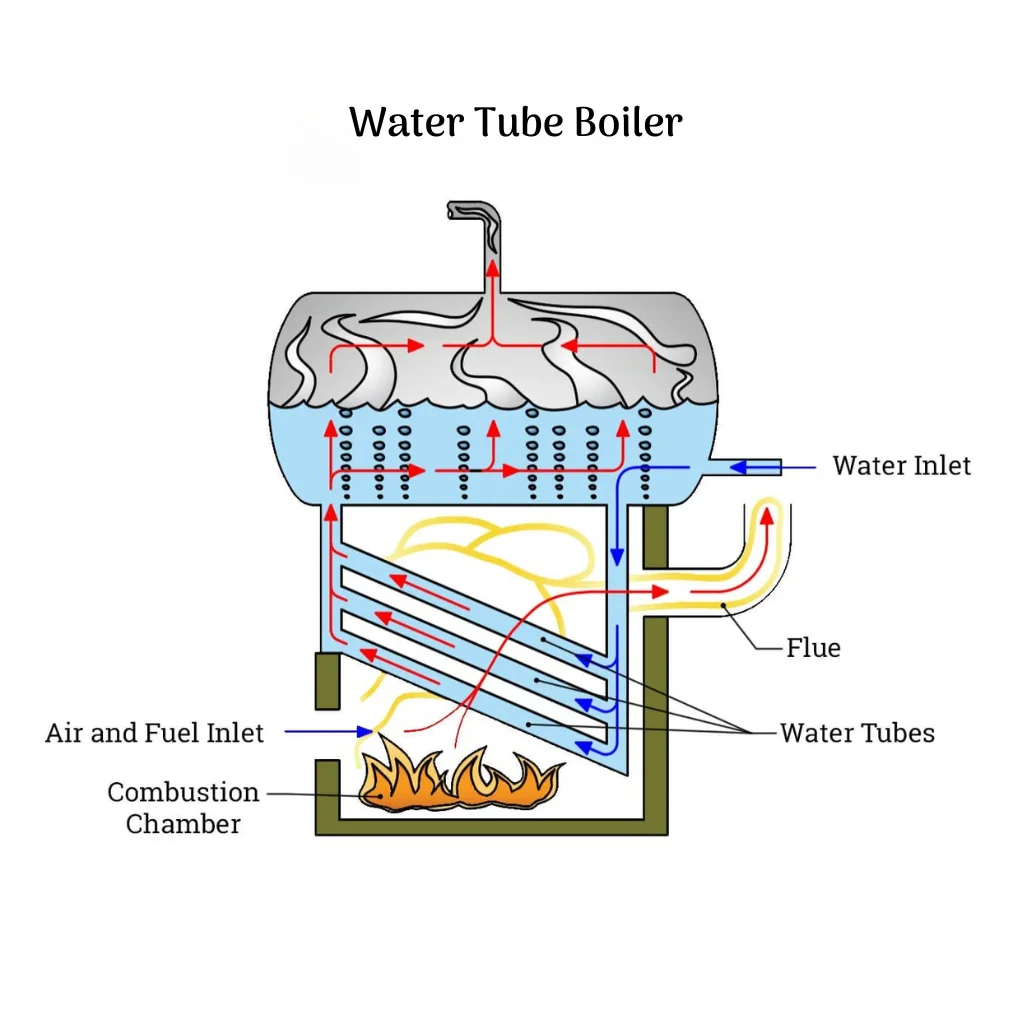Water tube boilers or High-Pressure Steam Boiler are a vital component in the realm of industrial steam generation, distinguished by their compact design and high-performance capabilities.
In a water tube boiler, water flows through tubes heated externally by flue gases, unlike fire tube boilers which circulate hot flue gases through tubes surrounded by water.
This unique configuration not only enhances efficiency but also enables the production of steam at significantly higher pressures and temperatures, making them indispensable for industries requiring large-scale energy outputs or superheated steam. Their modular and compact design further caters to space-constrained installations, while their ability to handle variable steam loads ensures adaptability across diverse industrial processes.
How Water Tube Boilers Work
Water tube boilers are designed to efficiently generate steam by circulating water through tubes exposed to high-temperature combustion gases. Here’s a step-by-step breakdown of their operation:
Fuel combustion takes place in the boiler furnace, the furnace is designed as per the fuel characteristics and composition. Fuel ignition takes place to produce flue gases which participate in the heat transfer.
These hot flue gases flow around the water-filled tubes, transferring heat to the water inside. The tubes are strategically arranged for maximum heat absorption.
As the water temperature increases under pressure, it turns into steam. The steam rises and collects in a steam drum located at the top of the boiler.
To achieve superheated steam temperatures required for industrial applications, the steam is passed through a superheater section where the saturated steam is further heated.
The superheated steam is then directed to various equipment or processes, such as turbines for power generation or manufacturing operations.
This design ensures efficient heat transfer, faster steam generation, and adaptability to high-pressure and high-temperature requirements. Additionally, the forced circulation system prevents overheating and ensures consistent performance even under variable load conditions.
Advantages of Water Tube Boilers
Water tube boilers offer several benefits over other boilers types:
- High Efficiency: Their design allows for faster heat transfer and higher thermal efficiency.
- High Pressure and Steam Output: Capable of producing steam at pressures exceeding 100 bar and temperatures above 500°C.
- Safety: The smaller volume of water reduces risks associated with catastrophic failures.
- Scalability: Ideal for industries requiring variable steam loads or expansion capabilities.
Applications of Water Tube Boilers
Water tube boilers are widely used across various industries due to their versatility:
- Power Generation: Essential for electricity production in thermal power plants.
- Chemical Industry: Used for heating reactors and distillation columns.
- Food Processing: Facilitates sterilization, cooking, and pasteurization processes.
- Textile Industry: Provides consistent steam for dyeing and finishing operations.
- Oil Refineries: Supports crude oil heating and other refinery processes.
Types of Water Tube Boilers
Several types of water tube boilers cater to specific industrial needs:
- D-Type Boilers: Compact design with high efficiency; commonly used in power plants.
- O-Type Boilers: Offers flexibility in installation; ideal for medium-scale industries.
- A-Type Boilers: Known for durability; suited for heavy-duty applications.
- Biomass WTB: Eco-friendly option utilizing renewable biomass fuels.
Comparing Water Tube Boilers with Fire Tube Boilers
| Feature | Water Tube Boiler | Fire Tube Boiler |
| Steam Pressure | High (up to 100+ bar) | Low (up to 10 bar) |
| Steam Output | Large-scale industrial applications | Small-scale heating applications |
| Efficiency | Higher | Moderate |
| Safety | Safer due to lower water volume | Riskier due to larger water volume |
Key Takeaways of Water Tube Boilers
Water tube boilers play a vital role in industries that demand high-pressure steam and consistent performance. Moreover, they offer energy-efficient solutions and compact designs, making them ideal for space-constrained facilities. As a result, these boilers provide unmatched benefits that cater to a wide range of industrial applications.
At Thermodyne Engineering Systems, we specialize in delivering customized water tube boiler solutions that not only optimize fuel consumption but also significantly boost operational efficiency.
To learn more about our advanced steam boiler systems or to request a tailored solution for your industry, contact us today and take the first step toward enhanced performance and sustainability.
FAQs
Water Tube Boilers are ideal for high-pressure, high-temperature applications requiring rapid steam generation, such as in power plants or large industrial processes.
Fire Tube Boilers are ideal for small-scale operations with low-pressure steam needs, offering a cost-effective solution due to their straightforward design.
A water tube boiler circulates water through externally heated tubes to produce steam. It’s ideal for high-pressure, high-temperature industrial applications.
Industries like power generation, oil and gas, chemical processing, steel manufacturing, and pulp and paper rely on them for high-pressure steam needs.
Common fuels include natural gas, propane, diesel, coal, and biomass.
Types include Babcock & Wilcox, Stirling, Lamont, Benson (supercritical), and A/D/O-type boilers.
Unlike fire tube boilers, water tube boilers handle higher pressures and larger steam outputs. Therefore, industries like power generation, chemical processing, and oil refining prefer them for their superior efficiency and safety.
Absolutely. At Thermodyne Engineering Systems, we offer tailored water tube boiler solutions. As a result, clients receive systems that align perfectly with their process requirements, space constraints, and fuel types.






